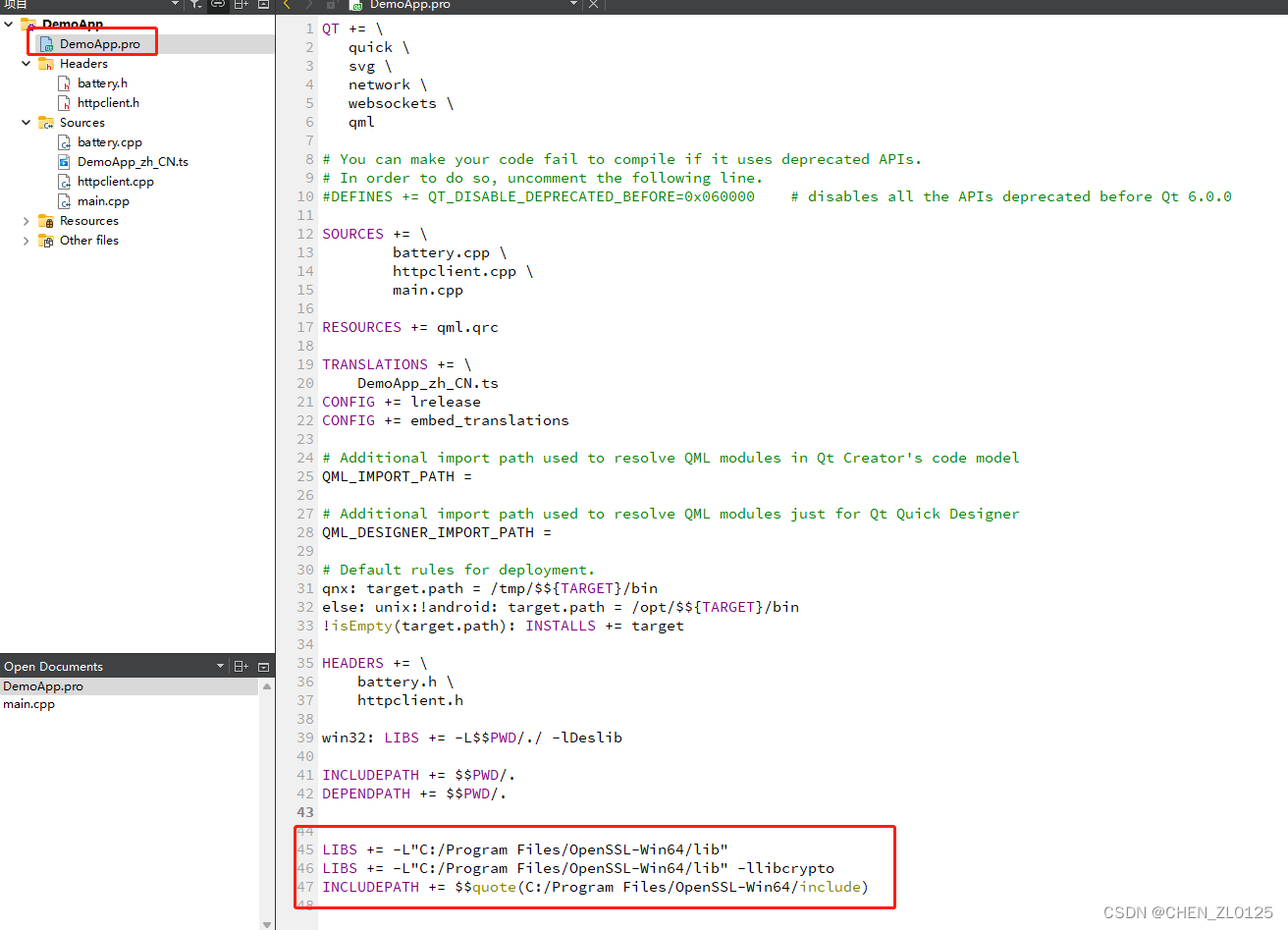首先安装Openssl,然后QT项目的pro文件中添加引用

但是加密出来的内容未转码,显示的是乱码,后台需要的是HEX,增加加密后字符串转换,根据自己的需求修改部分代码。main.cpp 代码如下
#include <battery.h>
#include <QGuiApplication>
#include <QQmlApplicationEngine>
#include <QLibrary>
#include <QLocale>
#include <QTranslator>
#include <iostream>
#include <fstream>
#include <sstream>
#include <string>
using namespace std;
#include <openssl/des.h>
//加密 cbc pkcs5padding 本身实现 //pkcs7padding 跟 pkcs5padding是同样的
std::string des_cbc_pkcs5_encrypt(const std::string &clearText)
{
static unsigned char cbc_iv[8] = {'p', 'a', 's', 's', 'w', 'o', 'r', 'd'};
//初始化IV向量【我这边密码与IV相同】
std::string strCipherText;
DES_cblock keyEncrypt, ivec;
memcpy(keyEncrypt, cbc_iv, sizeof(cbc_iv));
DES_key_schedule keySchedule; //密钥表
DES_set_key_unchecked(&keyEncrypt, &keySchedule); //设置密钥,且不检测密钥奇偶性
memcpy(ivec, cbc_iv, sizeof(cbc_iv));
// 循环加密,每8字节一次
const_DES_cblock inputText;
DES_cblock outputText;
std::vector<unsigned char> vecCiphertext;
unsigned char tmp[8];
for (int i = 0; i < clearText.length() / 8; i++)
{
memcpy(inputText, clearText.c_str() + i * 8, 8);
DES_ncbc_encrypt(inputText, outputText, 8, &keySchedule, &ivec, DES_ENCRYPT); //加密
memcpy(tmp, outputText, 8);
for (int j = 0; j < 8; j++)
vecCiphertext.push_back(tmp[j]);
//重置ivec
memcpy(ivec, outputText, 8);
}
if (clearText.length() % 8 != 0)
{
int tmp1 = clearText.length() / 8 * 8;
int tmp2 = clearText.length() - tmp1;
memset(inputText,(8-tmp2), 8);
memcpy(inputText, clearText.c_str() + tmp1, tmp2);
}
else
{
memset(inputText,8, 8);
}
// 加密函数
DES_ncbc_encrypt(inputText, outputText, 8, &keySchedule, &ivec, DES_ENCRYPT); //加密
memcpy(tmp, outputText, 8);
for (int j = 0; j < 8; j++)
vecCiphertext.push_back(tmp[j]);
strCipherText.clear();
strCipherText.assign(vecCiphertext.begin(), vecCiphertext.end());
return strCipherText;
}
//解密 cbc pkcs5padding 本身实现 //zeropadding / pkcs7padding 跟 pkcs5padding是同样的
std::string des_cbc_pkcs5_decrypt(const std::string &cipherText)
{
static unsigned char cbc_iv[8] = {'p', 'a', 's', 's', 'w', 'o', 'r', 'd'};
//初始化IV向量
std::string clearText;
DES_cblock keyEncrypt, ivec;
memcpy(keyEncrypt, cbc_iv, sizeof(cbc_iv));
DES_key_schedule keySchedule; //密钥表
DES_set_key_unchecked(&keyEncrypt, &keySchedule); //设置密钥,且不检测密钥奇偶性
memcpy(ivec, cbc_iv, sizeof(cbc_iv));
// 循环解密,每8字节一次
const_DES_cblock inputText;
DES_cblock outputText;
std::vector<unsigned char> vecCleartext;
unsigned char tmp[8];
for (int i = 0; i < cipherText.length() / 8; i++)
{
memcpy(inputText, cipherText.c_str() + i * 8, 8);
DES_ncbc_encrypt(inputText, outputText, 8, &keySchedule, &ivec, DES_DECRYPT); //解密
memcpy(tmp, outputText, 8);
for (int j = 0; j < 8; j++)
vecCleartext.push_back(tmp[j]);
//重置ivec
//memcpy(ivec, outputText, 8); //解密过程不须要用前一块的结果做为下一块的IV
}
if (clearText.length() % 8 != 0)
{
int tmp1 = clearText.length() / 8 * 8;
int tmp2 = clearText.length() - tmp1;
memset(inputText,0, tmp2);
memcpy(inputText, cipherText.c_str() + tmp1, tmp2);
DES_ncbc_encrypt(inputText, outputText, tmp2, &keySchedule, &ivec, DES_DECRYPT); //解密
memcpy(tmp, outputText, tmp2);
for (int j = 0; j < 8; j++)
vecCleartext.push_back(tmp[j]);
}
clearText.clear();
clearText.assign(vecCleartext.begin(), vecCleartext.end());
return clearText;
}
// 加密后密文转hex
string StringToHex(const std::string& data)
{
const std::string hex = "0123456789ABCDEF";
std::stringstream ss;
for (std::string::size_type i = 0; i < data.size(); ++i)
ss << hex[(unsigned char)data[i] >> 4] << hex[(unsigned char)data[i] & 0xf];
std::cout << ss.str() << std::endl;
return ss.str();
}
//---------------------以上代码可以写在一个单独的头文件中---------------------------------
int main(int argc, char *argv[])
{
#if QT_VERSION < QT_VERSION_CHECK(6, 0, 0)
QCoreApplication::setAttribute(Qt::AA_EnableHighDpiScaling);
#endif
QGuiApplication app(argc, argv);
{
string result = des_cbc_pkcs5_encrypt("123456");
string hexResult = StringToHex(result);
qDebug() << "---------hex---------- " << QString::fromStdString(hexResult);
}
QTranslator translator;
const QStringList uiLanguages = QLocale::system().uiLanguages();
for (const QString &locale : uiLanguages) {
const QString baseName = "DemoApp_" + QLocale(locale).name();
if (translator.load(":/i18n/" + baseName)) {
app.installTranslator(&translator);
break;
}
}
QQmlApplicationEngine engine;
const QUrl url(QStringLiteral("qrc:/main.qml"));
QObject::connect(&engine, &QQmlApplicationEngine::objectCreated,
&app, [url](QObject *obj, const QUrl &objUrl) {
if (!obj && url == objUrl)
QCoreApplication::exit(-1);
}, Qt::QueuedConnection);
engine.load(url);
return app.exec();
}